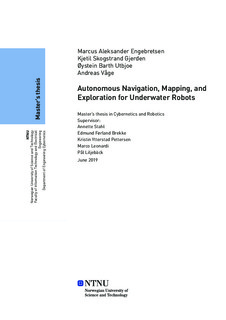Autonomous Navigation, Mapping, and Exploration for Underwater Robots
Master thesis
Permanent lenke
http://hdl.handle.net/11250/2625713Utgivelsesdato
2019Metadata
Vis full innførselSamlinger
Sammendrag
Denne masteroppgaven legger frem, og implementerer, en arkitektur for et autonomtsystem som er i stand til kontektsbasert resonnering under inspeksjonsoppdrag utførtmed ubemannede undervannsfartøy. For å forenkle design- og implementasjonsprosessenhar arkitekturen blitt delt inn i fem undermoduler: maskinvare, simultan lokalisering ogkartlegging (SLAM), klassifisering, planlegging og kontroll. Utvikling av disse moduleneundergikk fire hovedfaser: ytelsesspesifikasjon, design, implementasjon og testing. Somfølge av dette har hver av undermodulene blitt verifisert, både individuelt og kombinertmed hverandre, for å luke ut software bugs og svakheter som kunne forringe totalsystemetsytelse.En tilpasset stereovisuell-treghetssensor ble konstruert slik at presis undervannstestingav toppmoderne visuelle SLAM-metoder (VSLAM) kunne gjennomføres. Ved å kombinereen moderne VSLAM-metode og en avansert objektgjenkjenningsalgoritme, ble seman-tiske kart generert for å gi økt kontekstbevissthet i uutforskede omgivelser. Gjennombruk av en informert, asymptotisk optimal samplingbasert metode, produserer planleg-gingsmodulen gjennomførbare, kollisjonsfrie baner som er i overensstemmelse med C 2 -kontinuitetsrestriksjonene pålagt av kontrollsystemet. Ved å kombinere planleggingsmod-ulen med en informasjonsdrevet randbasert utforskningsmetode, ble et system for autonomutforskelse av ukjente omgivelser implementert. Kontrollmodulen bestod av et uniformtglobalt asymptotisk stabilt kaskadebasert styringssystem som oppnådde full konvergens på3D-kurver forsynt fra planleggingsmodulen.For å løse det spesifikke problemet med autonom rørinspeksjon med en svømmendeundervannsmanipulator ble klassifisering og planleggingsmodulene designet for å kombin-ert kunne planlegge ruter basert på semantisk informasjon om omgivelsene som, sammenmed utforskningsmodulen, kunne håndtere situasjoner hvor sporet av røret gikk tapt underoperasjonen. This thesis proposes a system architecture for an autonomous system capable of context-based reasoning when performing autonomous mapping and inspection tasks with un-manned underwater vehicles. To simplify design and implementation, the system architec-ture was divided into five submodules: hardware, simultaneous localization and mapping(SLAM), classification, path planning, and control. Development of these modules wentthrough four main phases: performance specification, design, implementation, and testing.Consequently, each submodule was verified, both individually and in pairs, to weed outbugs and weaknesses that could impair the performance of the complete system.A custom stereo-visual-inertial sensor was constructed to allow for precise testingof state-of-the-art visual SLAM (VSLAM) methods underwater. Through the integrationof a VSLAM method and an advanced object detection algorithm, semantic maps weregenerated for increased context-awareness in unknown environments. Using an informed,asymptotically optimal sampling-based approach, the planning module produced feasible,collision-free paths consistent with the C 2 continuity constraint imposed by the controlsystem. By combining the planning module with an information-driven frontier explorationstrategy, an autonomous exploration method was implemented. The control module con-sisted of a uniform global asymptotically stable cascaded guidance and kinematic controlalgorithm, which achieved full body convergence on the 3D curves provided by the planningmodule.To solve the specific case of autonomous pipe inspection with an underwater swimmingmanipulator, the classification and planning modules were designed to plan routes based onsemantic environment information, which, combined with the exploration module, couldhandle cases where the pipe was lost.
